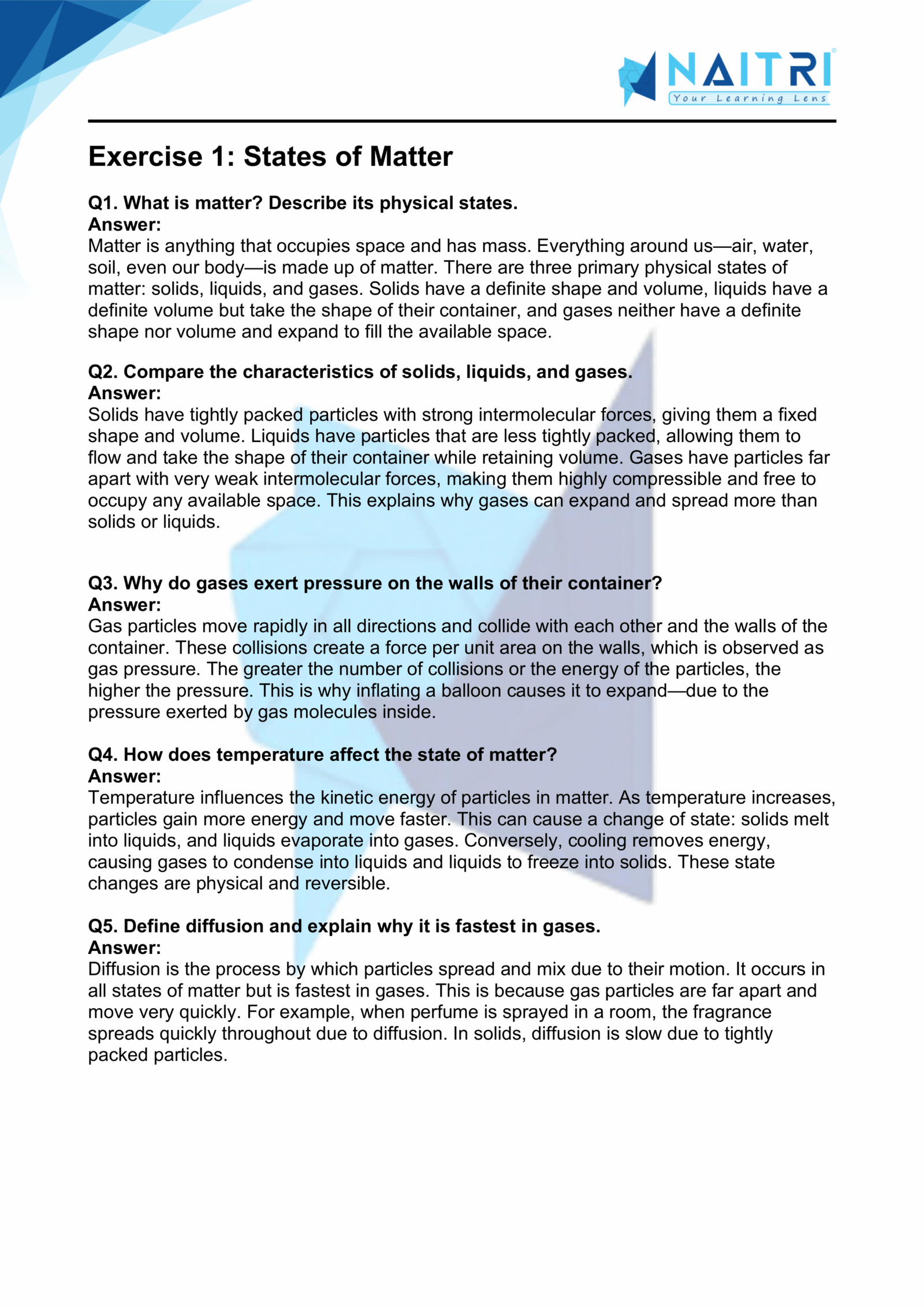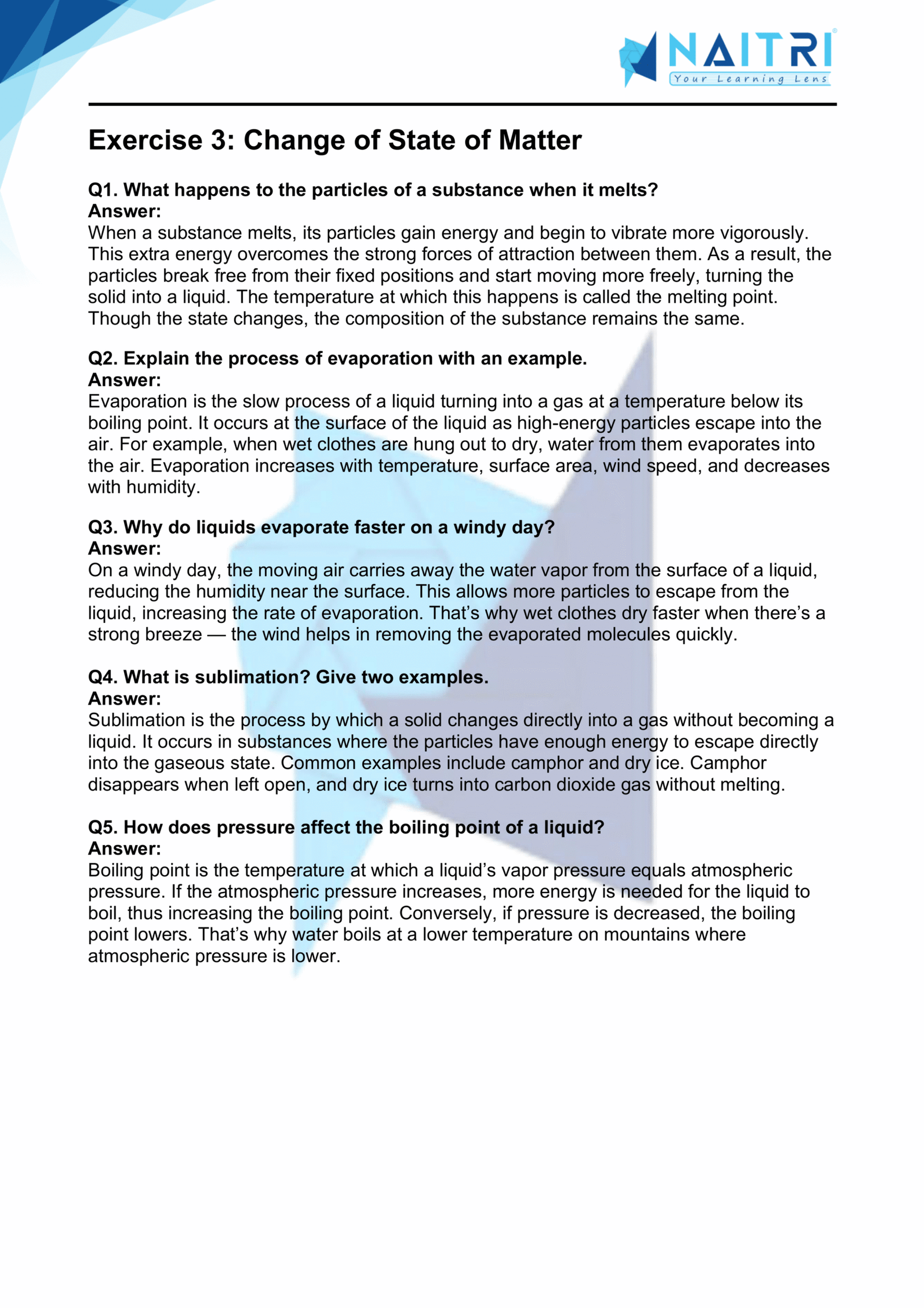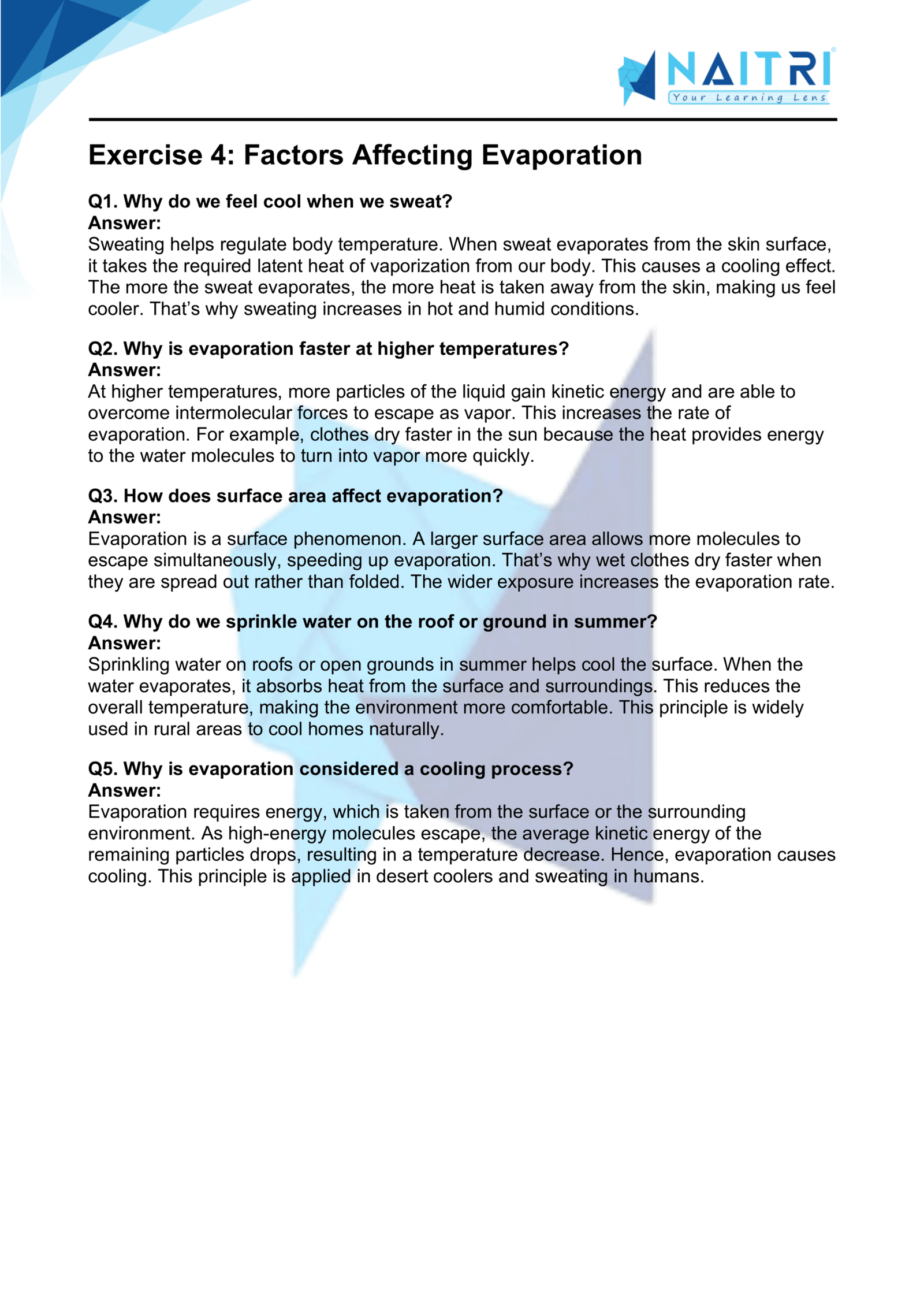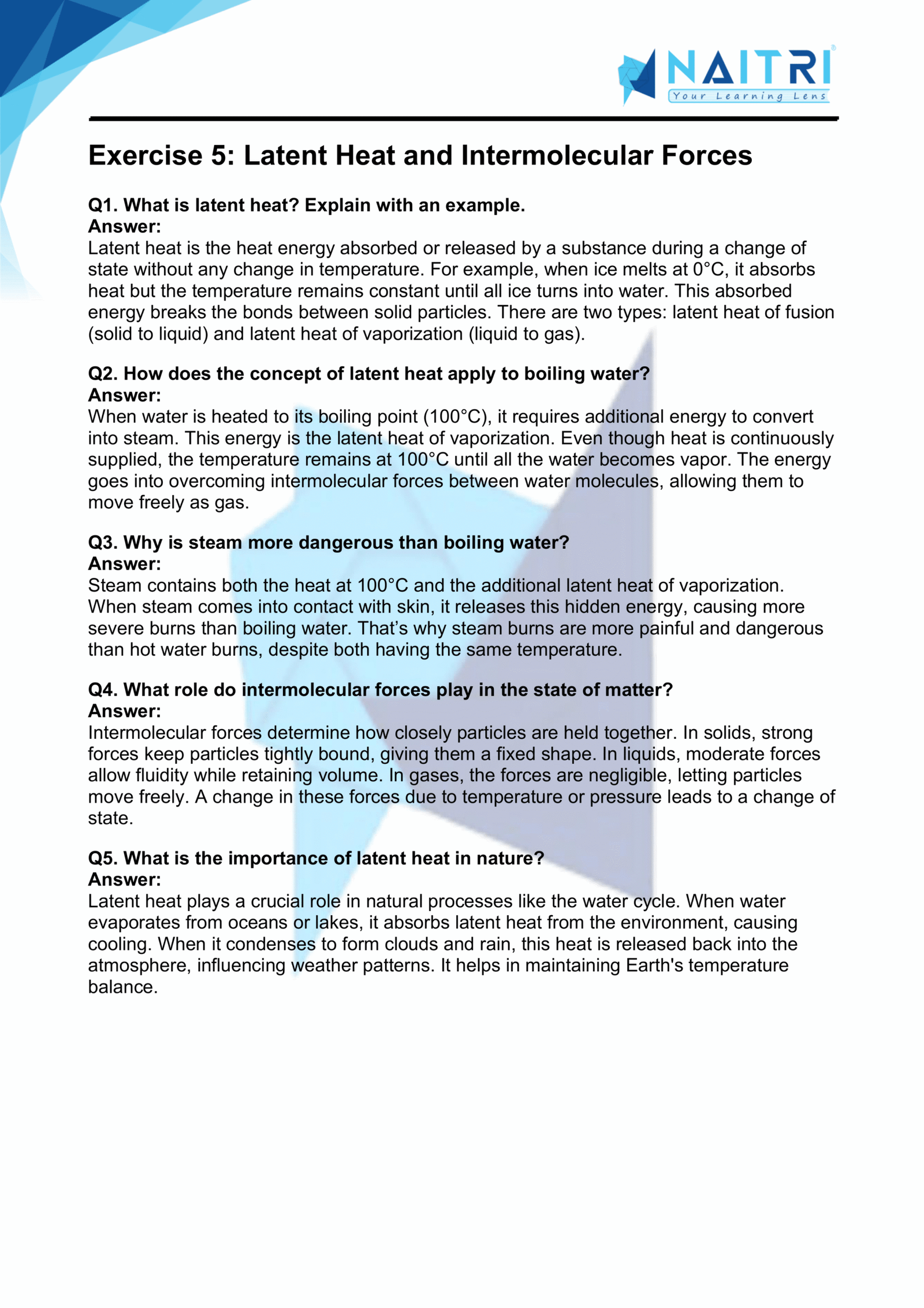NCERT Solutions Class 9 Science Chapter 1 – Matter in Our Surroundings
NCERT Solutions for Class 9 Science Chapter 1 – Matter in Our Surroundings are essential for understanding key Chemistry concepts in the CBSE curriculum. These well-structured answers help students grasp topics like states of matter, interconversion, evaporation, and more. Designed as per the latest syllabus, these solutions strengthen conceptual clarity and improve exam preparation. Ideal for revision and practice, they encourage logical thinking and scientific understanding, making them a valuable study tool for scoring well in Class 9 Science exams.
NCERT Solutions Class 9 Science – Matter in Our Surroundings – Exercise Images





Experience Science Like Never Before – With AR!
Understanding Matter in Our Surroundings is now more exciting and immersive! With the NAITRI App, you can explore complex science concepts through Augmented Reality (AR). Watch particles move, states of matter change, and real-life examples come alive — right in front of you. Our AR-powered lessons make learning interactive, 3D, and fun, helping you retain concepts better and enjoy every topic.



Visualize . Interact . Understand . The future of learning is here
Matter in Our Surroundings – Important Questions with Answers
1. Define matter. Give two examples.
Answer: Matter is anything that has mass and occupies space. Examples: air and water.
2. State the characteristics of particles of matter.
Answer:
Particles are very small.
They have spaces between them.
They are in constant motion.
They attract each other.
3. Why do solids have a fixed shape but gases do not?
Answer: Solids have tightly packed particles with strong intermolecular forces, while gases have loosely packed particles that move freely.
4. Give reasons: Gases are highly compressible but solids are not.
Answer: Gas particles have large spaces between them, allowing compression. Solid particles are closely packed, leaving no space for compression.
5. Differentiate between diffusion in liquids and gases.
Answer:
Diffusion is faster in gases due to high particle speed.
It is slower in liquids due to stronger intermolecular forces.
6. List any three differences between solids, liquids, and gases.
Answer:
| Property | Solid | Liquid | Gas |
|---|---|---|---|
| Shape | Fixed | No fixed | No fixed |
| Volume | Fixed | Fixed | No fixed |
| Compressibility | Negligible | Slight | High |
7. What is the effect of temperature on the motion of particles?
Answer: An increase in temperature increases the kinetic energy of particles, making them move faster.
8. What is the boiling point of water? What happens at this point?
Answer: The boiling point of water is 100°C. At this point, water changes into steam (gas) without a rise in temperature.
9. Why does the temperature remain constant during the melting of ice?
Answer: The heat supplied is used to break the bonds between ice molecules (latent heat of fusion), not to raise temperature.
10. Define the term sublimation. Name two sublimating substances.
Answer: Sublimation is the process where a solid changes directly to gas without becoming liquid. Examples: camphor and ammonium chloride.
11. Explain why a gas fills the entire volume of the container.
Answer: Gas particles move freely in all directions due to weak intermolecular forces and occupy all available space.
12. Define latent heat of vaporisation with an example.
Answer: The amount of heat required to convert 1 kg of a liquid into gas without changing its temperature. Example: boiling water into steam.
13. Why do wet clothes dry faster on a windy day?
Answer: Wind increases the rate of evaporation by removing the water vapour from the surface quickly.
14. What is evaporation? List four factors affecting it.
Answer:
Evaporation is the process of liquid changing into vapour at temperatures below its boiling point.
Factors:
Surface area
Temperature
Wind speed
Humidity
15. Why is water stored in earthen pots cooler than in plastic bottles?
Answer: Water seeps through the pores and evaporates from the pot’s surface, taking heat from the water and cooling it.
16. Why do we feel cool when we sit under a fan after sweating?
Answer: The fan increases evaporation of sweat, which absorbs heat from our body, causing a cooling effect.
17. Define condensation and give one real-life example.
Answer: Condensation is the process of gas changing into liquid. Example: Water droplets on the outside of a cold bottle.
18. Explain with reasons: Gases have more kinetic energy than solids.
Answer: Gas particles move more freely and rapidly due to weaker intermolecular forces, giving them higher kinetic energy.
19. What is meant by the interconversion of states of matter?
Answer: It is the process of changing matter from one state to another (e.g., solid to liquid) by changing temperature or pressure.
20. State the two conditions under which a gas can be liquefied.
Answer:
Increasing pressure
Lowering temperature
21. Write one difference between evaporation and boiling.
Answer:
Boiling: Happens at a fixed temperature (boiling point).
Evaporation: Can occur at any temperature.
22. What is meant by the term ‘fluid’? Which states of matter are fluids?
Answer: Fluids are substances that can flow. Liquids and gases are both fluids.
23. Why are naphthalene balls stored in clothes without leaving a liquid trace?
Answer: Because naphthalene undergoes sublimation, changing directly from solid to gas without becoming liquid.
24. Why is camphor used in religious rituals even though it disappears over time?
Answer: Camphor sublimes, releasing a fragrant gas, and its disappearing nature symbolizes purity and devotion.
25. Give one practical application of each: melting, boiling, sublimation, condensation, and evaporation.
Answer:
Melting: Ice turning into water in drinks
Boiling: Cooking food with boiling water
Sublimation: Storing clothes with naphthalene balls
Condensation: Formation of dew drops
Evaporation: Drying clothes under the sun
Matter in Our Surroundings introduces the foundational concept that everything around us is made of matter, which exists in different states—solid, liquid, and gas—based on particle arrangement and behavior. Through this chapter, students learn about the properties of matter, the interconversion between its states, and real-life applications like evaporation and condensation. Understanding concepts such as latent heat, sublimation, and diffusion helps build a scientific approach to everyday phenomena. Overall, this chapter lays the groundwork for advanced topics in Chemistry by encouraging logical thinking and curiosity about how matter behaves in our environment.
Related Chapters You May Like
- Chapter – 2 Is Matter Around Us Pure
- Chapter – 3 Atoms and Molecules
- Chapter – 4 Structure of the Atom
- Chapter – 5 The Fundamental Unit of Life
- Chapter – 6 Tissues
- Chapter – 7 Motion
- Chapter – 8 Force and Laws of Motion
- Chapter – 9 Gravitation
- Chapter – 10 Work and Energy
- Chapter – 11 Sound
- Chapter – 12 Improvement in Food Resources
Download Naitri App
Easy, Visual Learning — Right on Your Phone
Learn with Augmented Reality! The Naitri app makes CBSE and MP Board concepts interactive and fun — even in low-resource settings. Watch lessons, complete homework, take tests, and track progress — all in one place. Anytime. Anywhere.
Available on








